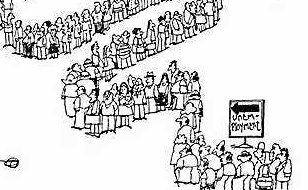How Will the Global Economic Crisis Affect Turkey?
The research also comments on how a likely crisis can be overcome with the least possible damage. Following is a summary evaluation of the research:
Halt in growth
The growth of the Turkish economy since 2002, has come to a halt irrespective of the foreign turmoil, due to a series of weaknesses. It can be said that the large foreign capital inflow does not adequately increase the capital accumulation and the growth potential.
Current account deficit the weak chain
The current account deficit is the most important factor that will determine the extent of the damage to the Turkish economy the global crisis will have. The current account deficit reached 38 billion dollars at the end of the year 2007 due to the rapidly growing foreign trade deficit. The deficit is approximately 8 percent of the 2007 national income.
The assets of foreigners as big as national income
Turkey’s growth, which accelerated in the 2000s was, to a large extent, due to an inflow of foreign capital. This increased dependence on owners of foreign capital. The size of the assets of foreigners has reached Turkey’s national income.
Inequalities on the budget growing
23 percent of the 34 percent direct tax share from the indirect tax, is income tax. However, taxes retained from wage-earners predominantly make up this type of tax. The corporation tax paid by banks and companies, which get the largest share from total income, remained at 9 percent within the total tax income in 2007.
Privatization as a tool to settle budget deficits
The amount transferred from privatizations to the budget was one percent of the total public revenue in 2004, two percent in 2005, 4.5 percent in 2006 and 4 percent in 2007.
Real inflation 20 percent
Turkey failed to meet its inflation target of 4 percent in 2007. Consumer price inflation reached 8,7 at the end of the year. After this fiasco, it seems very unlikely that Turkey will meet its inflation target of 4 percent in 2008. The 2008 global crisis will probably reinforce the rise in inflation. The inflation experienced especially by lower and middle class groups points at a totally different reality.
Real unemployment rate 20 percent
During the years 2002-2006 when the economy grew 7.3 percent annually in real terms, total employment increased on average 0.7 percent annually.
The employment rate in November 2006 was 21 million 235 thousand. It went down to 20 million 867 thousand in November 2007. In other words, in 2007, when there was a growth of 4,5-5 percent, the employment rate went down 1.7 percent instead of increasing. If we were to take into consideration the labour force, which the Turkish Statistical Institute does not specify as labour force due to a disagreement over definition, the formal employment number would be 25 million 267 thousand, the accession rate to labour force would be 51 percent; and the formal number of those unemployed would be 4 million 400 thousand.
The income gap widening
In 2007, exports reached 107 billion dollars. The greatest advantage over foreign markets was low salaries. This was achieved through disciplining large unemployed masses with hunger, and through the brutal exploitation of labour. The fact that the state’s taxation and expenditure policies are to the disadvantage of the lower and middle classes, reinforced the inequality of the distribution of income.
Regional disparities and measures for the southeast problem
The inequality between the east and west of Turkey has lead to very serious social and political problems, as well as increasing internal migration and rendering large cities unbearable. The Kurdish population feels like “the other” and their sense of belonging is damaged due to the fact that especially the East and Southeast Anatolia Region do not benefit from development. (MS/GG/EA/EÜ)
Government's Fooled As Dollar's Value Rises
Real Unemployment is 26 Percent, Future Bleak

Lower-Income Families Affected by Inflation
Oh Turks...Love, Protect and Trust Your Kurds!

Ten Thousand Dollars Per Capita? Palaver...










